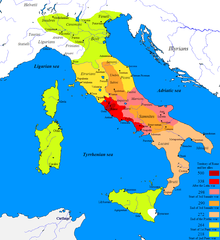218 BC
| Millennium: | 1st millennium BC |
|---|---|
| Centuries: | |
| Decades: | |
| Years: |
| 218 BC by topic |
| Politics |
|---|
| Categories |
| Gregorian calendar | 218 BC CCXVIII BC |
| Ab urbe condita | 536 |
| Ancient Egypt era | XXXIII dynasty, 106 |
| - Pharaoh | Ptolemy IV Philopator, 4 |
| Ancient Greek era | 140th Olympiad, year 3 |
| Assyrian calendar | 4533 |
| Balinese saka calendar | N/A |
| Bengali calendar | −810 |
| Berber calendar | 733 |
| Buddhist calendar | 327 |
| Burmese calendar | −855 |
| Byzantine calendar | 5291–5292 |
| Chinese calendar | 壬午年 (Water Horse) 2480 or 2273 — to — 癸未年 (Water Goat) 2481 or 2274 |
| Coptic calendar | −501 – −500 |
| Discordian calendar | 949 |
| Ethiopian calendar | −225 – −224 |
| Hebrew calendar | 3543–3544 |
| Hindu calendars | |
| - Vikram Samvat | −161 – −160 |
| - Shaka Samvat | N/A |
| - Kali Yuga | 2883–2884 |
| Holocene calendar | 9783 |
| Iranian calendar | 839 BP – 838 BP |
| Islamic calendar | 865 BH – 864 BH |
| Javanese calendar | N/A |
| Julian calendar | N/A |
| Korean calendar | 2116 |
| Minguo calendar | 2129 before ROC 民前2129年 |
| Nanakshahi calendar | −1685 |
| Seleucid era | 94/95 AG |
| Thai solar calendar | 325–326 |
| Tibetan calendar | 阳水马年 (male Water-Horse) −91 or −472 or −1244 — to — 阴水羊年 (female Water-Goat) −90 or −471 or −1243 |

Year 218 BC was a year of the pre-Julian Roman calendar. At the time it was known as the Year of the Consulship of Scipio and Longus (or, less frequently, year 536 Ab urbe condita). The denomination 218 BC for this year has been used since the early medieval period, when the Anno Domini calendar era became the prevalent method in Europe for naming years.
Events[edit]
By place[edit]
Hispania[edit]
- Fall of Saguntum to Hannibal of Carthage (or 219)[1]
- Hannibal crosses the Pyrenees and southern Gaul[1]
- Hannibal sets out with around 40,000 men and 50 elephants from New Carthage (Cartagena) to northern Spain and then into the Pyrenees where his army meets with stiff resistance from the Pyrenean tribes. This opposition and the desertion of some of his Spanish troops greatly diminishes his numbers, but he reaches the river Rhône facing little resistance from the tribes of southern Gaul.
- A Roman army under the consul Publius Cornelius Scipio is transported by sea to Massilia (modern Marseille) to prevent Hannibal from advancing on Italy, but returns to Italy on learning Hannibal has already crossed the river.
- A Roman army under Gnaeus Cornelius Scipio Calvus invades Spain.
Roman Republic[edit]
- Second Punic War
- A Roman army, under consul, Tiberius Sempronius Longus, assembles in Sicily to embark for Northern Africa. Longus managed to capture Malta from the Carthaginians.[2]
- Hannibal's crossing of the Alps: Hannibal took 38 North African war elephants across the Alps from Gaul into Cisalpine Gaul to invade Rome. Almost none of the elephants survived the harsh conditions of the Alps. This led to the Romans cancelling their invasion of Africa.
- Battle of Ticinus: Hannibal defeats Scipio.
- The Roman Senate orders Sempronius Longus to travel from Sicily to reinforce Scipio's troops.
- December 18: Battle of the Trebia: Hannibal defeats the combined Roman armies under Sempronius and Scipio.
Seleucid Empire[edit]
- Negotiations between the new Egyptian King Ptolemy IV and the Seleucid King Antiochus III collapse, and Antiochus III renews his advance, overrunning Ptolemy's forward defences, and gaining territory in Lebanon, Palestine and Phoenicia.
Births[edit]
Deaths[edit]
References[edit]
Wikimedia Commons has media related to 218 BC.
- ^ a b LeGlay, Marcel; Voisin, Jean-Louis; Le Bohec, Yann (2001). A History of Rome (Second ed.). Malden, Massachusetts: Blackwell. p. 77. ISBN 0-631-21858-0.
- ^ Castillo, Dennis Angelo (2006). The Maltese Cross: A Strategic History of Malta. Greenwood Publishing Group. pp. 20–26. ISBN 9780313323294.
